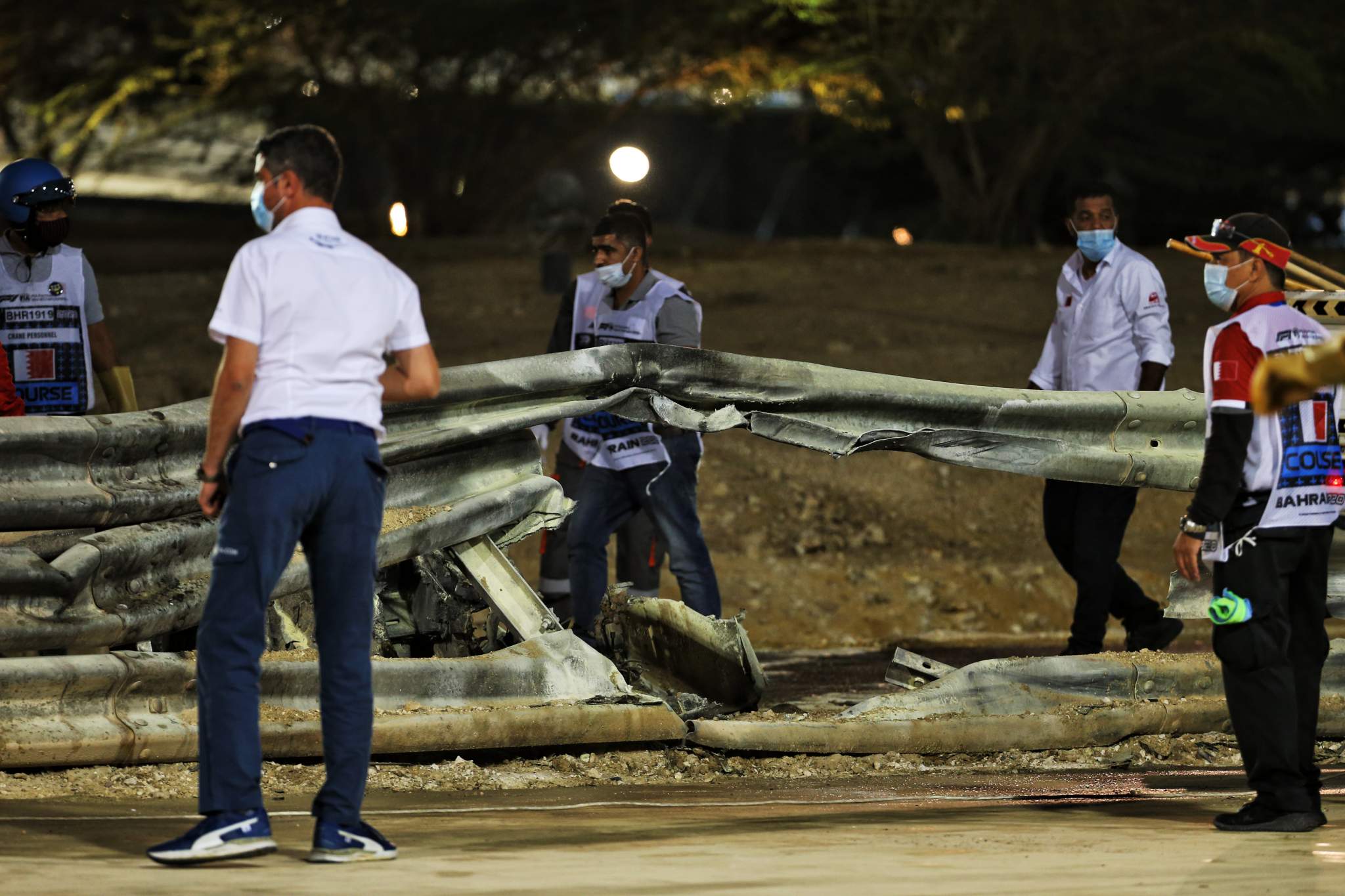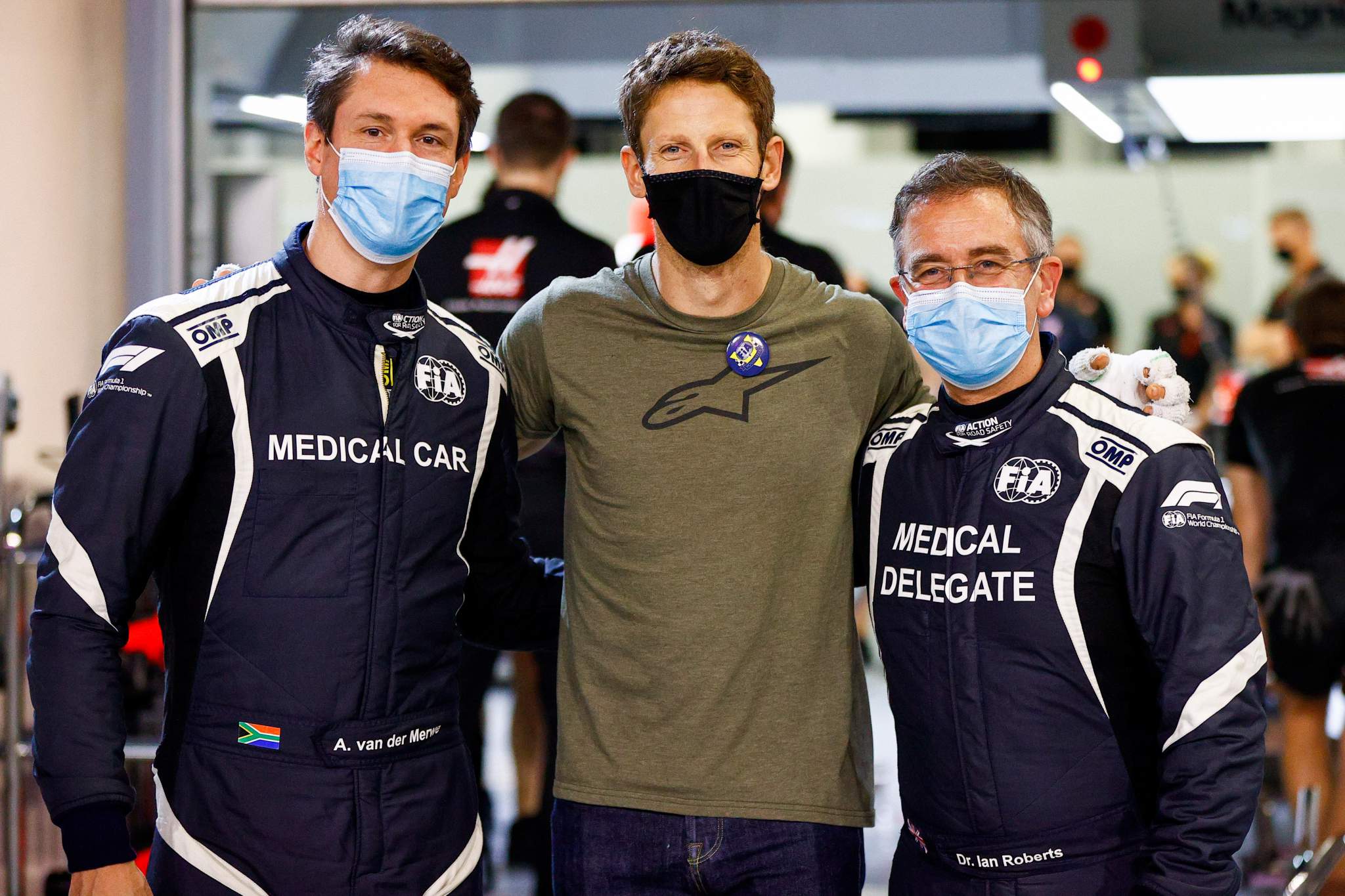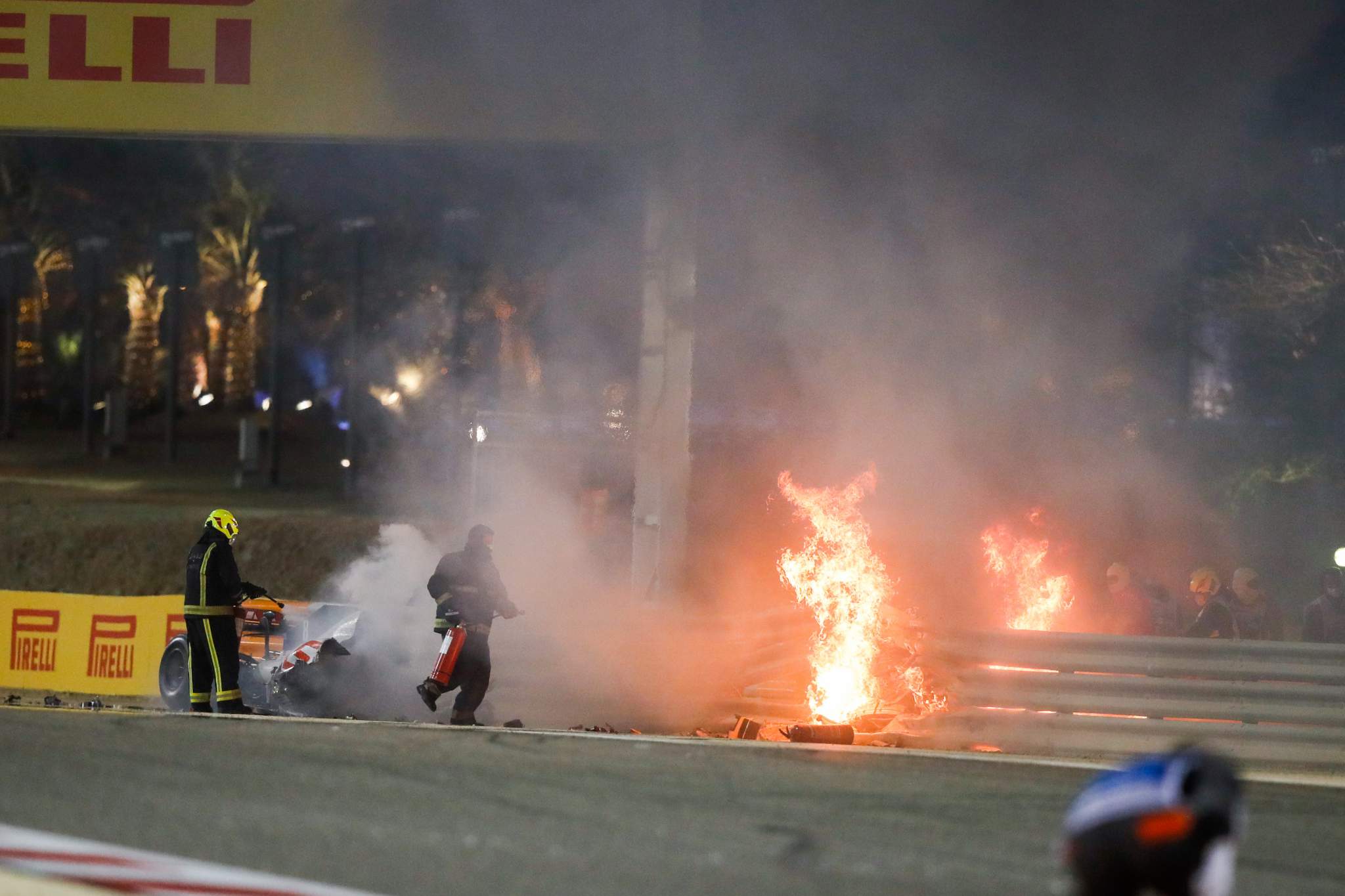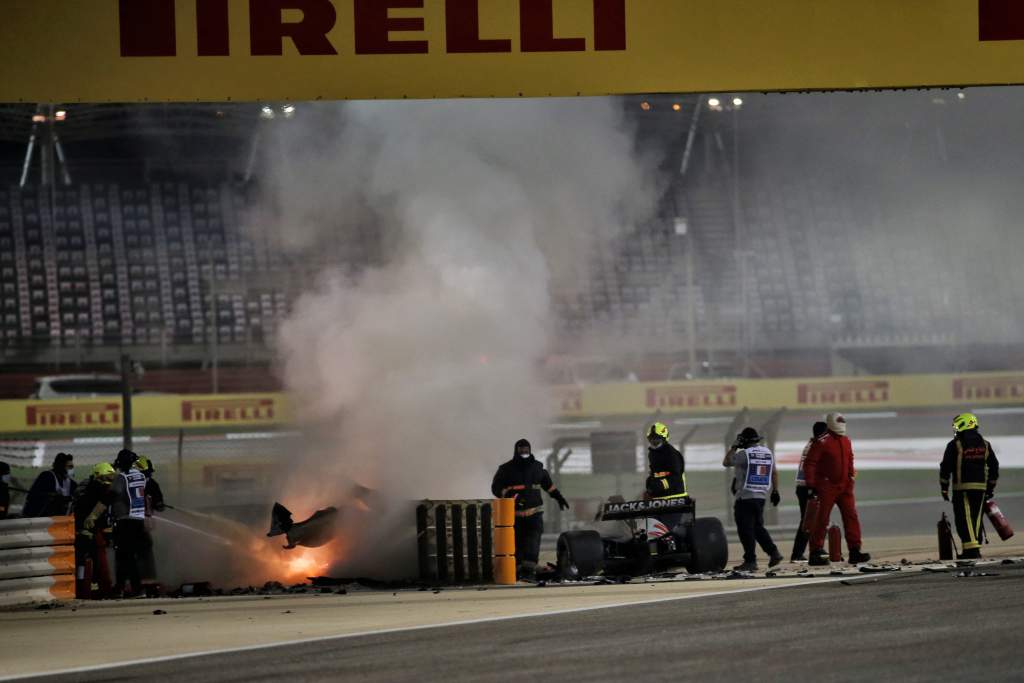Up Next

The FIA has revealed the findings of its investigation into Romain Grosjean’s fiery accident in last year’s Bahrain Grand Prix, as well as the areas that are being worked on to improve safety as a consequence.
The FIA safety department investigated all aspects of the accident through interviews with those involved, inspection of the physical evidence, video evidence and also information from the car’s accident data recorder and Grosjean’s in-ear accelerometers.
The work was peer-reviewed by the FIA serious accident study group under Jean Todt and has been presented to the relevant bodies including the World Motor Sport Council. The findings will be presented to the drivers on March 23.
“Important learnings have been drawn from these investigations that will drive our continuous mission to improve safety in Formula 1 and global motor sport,” said FIA president Jean Todt.
“The enduring commitment of the FIA, particularly the Safety Department, on reducing risks associated with motor sport enabled Romain Grosjean to maintain consciousness and survive an accident of this magnitude. Safety is and will remain FIA’s top priority.”

THE SPEEDS AND FORCES INVOLVED
The investigation found that Grosjean’s Haas was moving at 150mph when it made contact with Daniil Kvyat’s AlphaTauri and shed just 31mph between then and the impact – meaning it was still moving at 119mph when it hit the barriers.
“The car-to-car contact lifted the rear of Grosjean’s car, forcing it to yaw to the right and placing it on an out-of-control trajectory into the run-off area on the inside of the circuit,” said the report, adding that the contact with the barrier was at a 29-degree angle and with an “estimated yaw of 22 degrees to the direction of travel”.
That resulted in a peak force “equivalent to 67g” at the accident’s most violent point.
HOW THE FIRE STARTED
The report explains where the fuel that caused the dramatic fireball came from, though it does not provide any detail on the estimated amount of fuel involved.
“The car suffered extensive damage during the impact including separation of the power train assembly from the survival cell.
“The fuel tank inspection hatch on the left-hand side of the chassis was dislodged and the engine fuel supply connection was torn from the fuel tank ‘safety bladder’; both providing primary paths for the escape of fuel from the tank.”
It added: Fire was ignited during the final moments of the barrier impact, starting from the rear of the survival cell and progressing forwards towards the driver as the fire grew.”
‘SIGNIFICANT’ BATTERY DAMAGE
The role of the car’s energy recovery system and battery in the fire was heavily debated in the aftermath. The report did not address that element but confirmed that “the high voltage energy recovery system (ERS) battery was significantly damaged, with some parts of the ERS battery assembly remaining with the powertrain and others remaining attached to the survival cell.”

HOW GROSJEAN EXTRACTED HIMSELF
The report does not go into detail about the nature of the barrier failure that led to the detached front section of the car being wedged in the middle of the split guardrail when it came to rest.
“Following the failure of the middle rail of the barrier and significant deformation of the upper and lower rails, the survival cell was able to pierce the barrier and came to rest behind the barrier, constrained by the primary roll structure against the upper rail of the barrier,” it reads.
In the days after the crash, Grosjean gave a vivid description of the 28-second period from the accident finishing to successfully exiting the car.
The report explained how his escape was impeded by both damage within the cockpit and how his half of the car was jammed within the barrier.
“The resting position of the survival cell, relative to the upper rail of the barrier significantly restricted the path for driver egress.
“Due to damage to the survival cell and a number of components within the cockpit environment, Grosjean’s left foot was initially trapped as the car came to rest.
“The driver was able to free his foot by withdrawing it from his racing boot leaving the boot in the entrapped position in the car and then moved both the dislodged headrest and steering wheel to egress the car.”
Grosjean revealed in his first description of the crash that he initially thought he must be trapped in an upside down car and was going to wait for assistance.
“I feel like something is touching my head, so I sit back down in the car and my first thought was ‘I’m going to wait. I’m upside down against the wall so I’m going to wait until someone comes and helps me,'” he said last year.
“So I wasn’t in stress and obviously not aware at the time there is fire.
“Then I look right and left, and watching on the left I see fire. So I say ‘OK, well I don’t really have the time to wait here’.
“So next thing is that I tried to go up a bit more on the right, it doesn’t work.
“I go again on the left, it doesn’t work.
“I sit back down and then thought about Niki Lauda, his accident [at the Nurburgring in 1976], and thought ‘it couldn’t end like this, it couldn’t be my last race, it couldn’t finish like this. No way’.
“So I try again and I’m stuck. So I go back and then there’s the less pleasant moment where my body started to relax. I’m at peace with myself, and I’m going to die.
“I asked my question: ‘Is it going to burn my shoe or my foot or my hand? Is it going to be painful? Where is it going to start?’
“To me, that looks like two, three, four seconds. I guess it was milliseconds at the time. And then I think about my kids and I said ‘no, they cannot lose their dad today’.
“I don’t know why, but I decided to turn my helmet on the left-hand side and to go up like this and then try to twist my shoulder.
“That sort of works, but then I realise my foot is stuck in the car.
“So I sit back down, I pull as hard as I can on my left leg and my foot comes out of the shoe.
“Then I do it again and then the shoulders are going through, and at the time the shoulders are through I know I’m going to jump out.”

HOW THE MEDICAL CAR GOT THERE SO QUICKLY
The race was red-flagged within 5.5s of the impact, and the medical car carrying F1 medical rescue coordinator Dr Ian Roberts and a local doctor, and driven by Alan van der Merwe arrived at the scene within 11s.
This was partly because it used an access road to shortcut the Turn 1 complex, a decision the report said “demonstrated both local circuit knowledge and pre-planning”.
The report explained how all three then went straight into a “pre-determined role” in the accident response.
“Roberts went immediately to the scene of the incident and instructed a marshal to operate the dry powder extinguisher around the cockpit where he identified Grosjean as trying to make his egress,” it read.
“Van der Merwe retrieved a fire extinguisher from the rear of the FIA medical car whilst the local doctor prepared the trauma bag.”
Grosjean managed to get himself clear of the burning car unaided and was then assisted away from the accident scene by Dr Roberts.
Though he initially believed he had a broken foot in addition to his hand burns, Grosjean insisted on walking to the ambulance himself after a preliminary examination and attention to his burns in the medical car.
“I guess on the medical side, it wasn’t the perfect decision but they understood that, for me, it was key at the point that there was some footage of me walking towards the ambulance,” said Grosjean.
“Even though I’d walked out of the fire, I needed to send another strong message that I was OK and I was going to walk towards the ambulance.”

WHAT IS CHANGING AS A RESULT?
The FIA has issued an extensive list of key safety research projections that are ongoing that draw on the findings of the investigation.
In terms of the car, survival cell front geometry and load test regulation is being evaluated, as is the geometry of the front of the survival sell.
Rear-view mirrors are being reviewed, along with steering column mountings and the requirements of the headrest assembly. Haas team principal Guenther Steiner suggested at the team’s launch on Thursday that this was “to make it smaller. The headrest is still there but in parts so it cannot get stuck when it comes off”.
The failure modes of the power unit mounting are also being analysed along with research into wheel tethers, the improvement of safety fuel bladder installation and FIA standards across all single-seater categories. As part of this, fuel homologation will also include the requirement to be compatible with the fuel bladder material.
Steiner has also confirmed that changes have been made to the regulations governing the fuel hatch, which may no longer be attached to the chassis.
Track design is also being improved, with increased functionality for circuit safety analysis software (CSAS), as well as a review of barrier openings and a review of the guidelines for circuit homologation.
An investigation has also begun into improving the heat transfer index of gloves after Grosjean suffered burns.
This is one of several areas of driver protection set to be studied for improvement, which includes the visor opening/locking mechanisms and their capacity to withstand fire and the possibility of an improved activation systems for onboard fire extinguishers.
Rescue vehicles are also being updated with additional guidance and training for all member organisations.
The FIA safety department also plans further research projects that include options for proximity warning systems and electronic visibility aids, improvements to existing barriers, novel barrier systems and fire-fighting and protective equipment.








